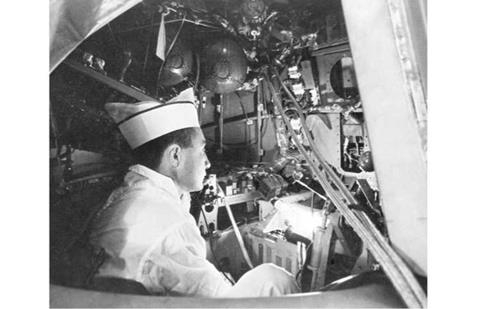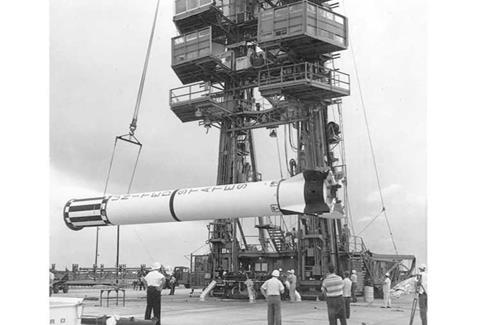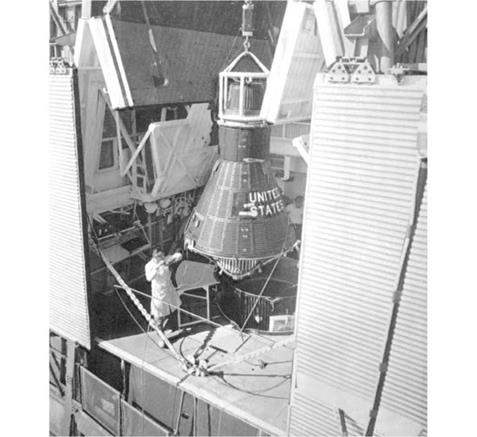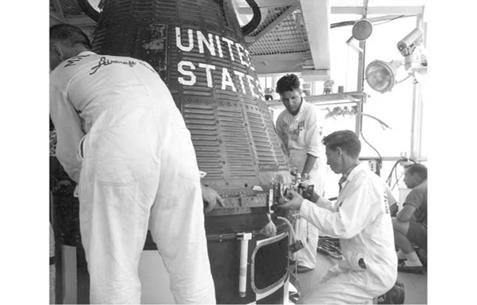FINAL PREPARATIONS
In time Grissom basically became a living, integral part of Spacecraft No. 11, as the component that no mechanism could replace. His confidence had grown to the point that he knew his vehicle as well as, or better than, any high-performance aircraft he had flown in the past.
“Actually, during the final weeks and days before the launching of MR-4 „.I felt really good,” Grissom recalled in We Seven. “We kept spotting problems, as we knew we would. But there were very few of them, considering the state of the art, and the simulations we went through for practice went very well. If anything was building up inside me, it was that I was anxious. I kept wanting to go tomorrow, and I guess I got slightly impatient whenever some technician came up with a new modification in the system that might have caused a long delay if we had accepted it. The only thing I was afraid of was that something might happen to prevent me from making the flight.”13
On Friday, 23 June, Redstone launch vehicle MRLV-8 was installed on Launch Pad 5 for a mission expected in mid-July. Technicians began conducting extensive checkouts of the 69-foot rocket before mating it with the one-ton Mercury capsule, checking and rechecking to ensure the booster was ready for the upcoming flight. Once the launch pad crews had completed their final inspections and systems tests, Liberty Bell 7 would be moved from Hangar S to the launch pad and mated with the Redstone. Three Redstone rockets, including the one on the launch pad, remained for the planned Mercury suborbital flights. If the NASA schedule held, the last two launchings would take place in August and September.
|
Grissom conducts systems checks inside Liberty Bell 7. (Photo: NASA) |
|
The MR-4 Redstone being raised to vertical at Launch Complex 5. (Photo: NASA) |
|
Preparing to mate Liberty Bell 7 with the Redstone booster. (Photo: NASA) |
As Grissom recalled, it was a happy day for him when the booster and spacecraft were finally being spliced together. Incredibly, however, he was almost barred from being on the pad to observe the process. “I had locked my hard hat in the office and forgotten the key, and no one is allowed near an active gantry without a special hard hat to protect his head. Someone finally loaned me one, and I made it just in time.”14 Over the next three days, further compatibility tests involving thousands of parts would take place in order to ensure that all systems involving the spacecraft and booster worked together. George Baldwin served as a manufacturing foreman with McDonnell, overseeing the launch pad crew. He spent his days at the Cape in preparing for the Mercury launches. He still recalls that time with great fondness, as he said in 2011. “My experience with it was wonderful because of the camaraderie and willingness of the workers and engineers [and] because everyone had one goal in mind. It was a time when we had Sputnik going over top of our heads, and [President Kennedy] setting the goal of going to the Moon within the decade. It was an absolutely exciting time.”15 As final preflight operations proceeded on schedule at the Cape, NASA personnel began manning stations on Bermuda and Grand Bahama Island in readiness to track
|
Mating the Mercury spacecraft with the Redstone booster. (Photo courtesy Kansas Cosmosphere and Space Center) |
the MR-4 flight. At sea, ships and aircraft of the Mercury recovery force were either on station or moving into position, ready to pluck Grissom and his capsule from the sea.














